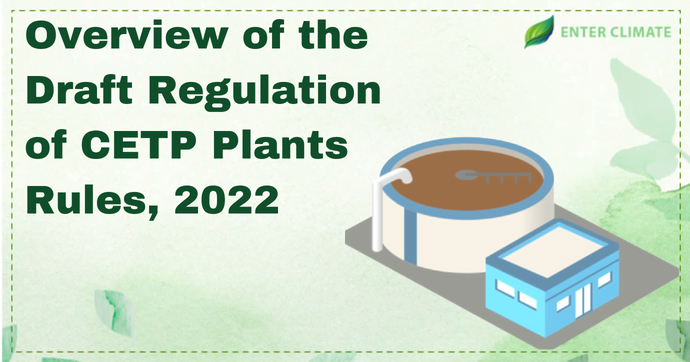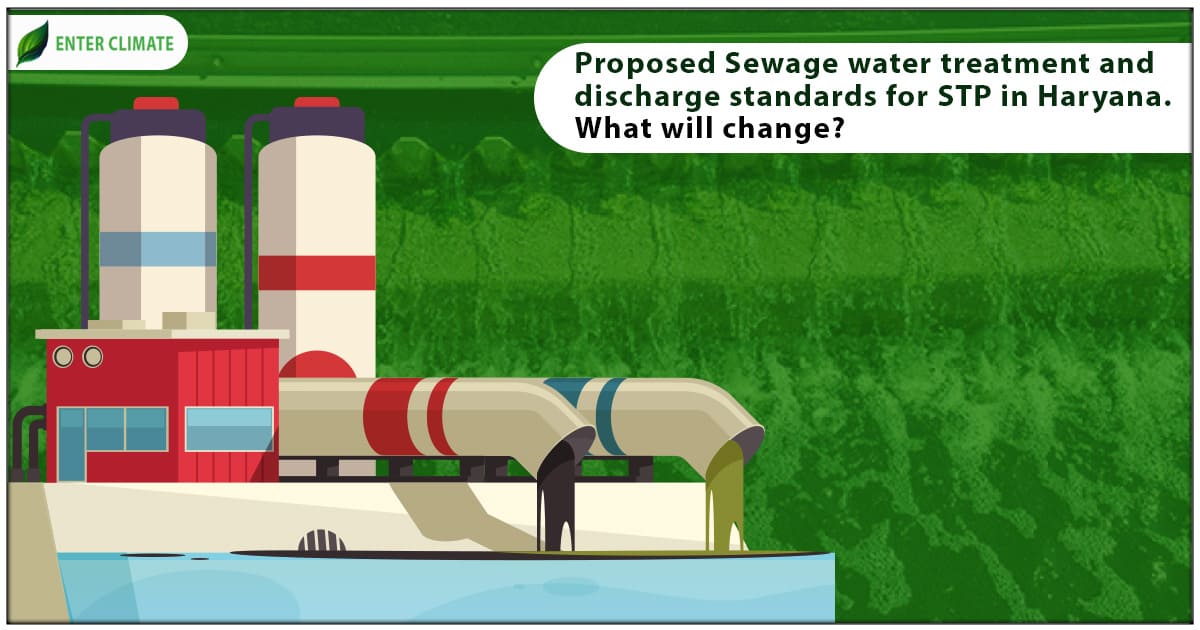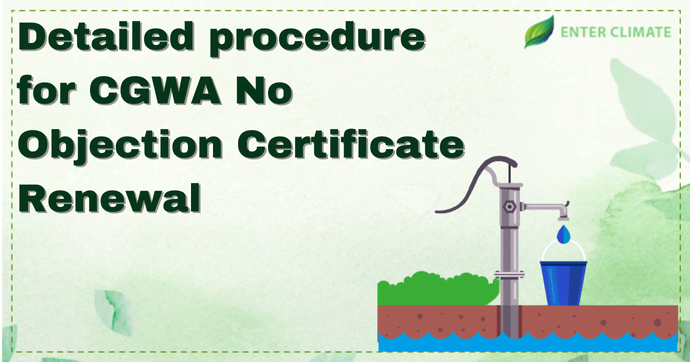Overview of the Draft Regulation of CETP Plants Rules, 2022
 07 Feb, 2023
07 Feb, 2023 
Manufacturing processes in many industries generate by-products that are washed into wastewater.This wastewater, i.e. also called effluent, is converted into treated effluent with the aid of a Common Effluent Treatment Plant (CETP). The waste obtained from ETP is the sludge which is the solid part which is separated from wastewater by ETP.The treated water is then reused by the industry or discharged into the environment. Under sections 6 and 25 of the Environment (Protection) Act, 1986, the effluent quality standards for CETPs were notified by MoEF&CC in 1991 and subsequently revised in 2016.Recently, a draft notification, i.e. “Draft Regulation of CETP Plants Rules, 2022”, was issued by the MoEF&CC in January 2023 to address the enforcement issues/bottlenecks/multiplicity of roles of the stakeholders. The following article will explain the key highlights of the rules in the context of different stakeholders i.e.
- CETP operating agencies (or Agencies)
- Member Industries of a CETP
- Governmental Agencies (SPCBs/PCCs)
Responsibilities of CETP operating agencies under the CETP Plants Rules, 2022
CETPs will now perform a vital role in thewaste compliance requirements of the industries. The Effluent Treatment Plants businesses will seemassive demand in the coming years after the said draft rules are enacted due to the monitoring and regulatory compliances for industries that will need such services.CETPs will also act as a point for the Pollution Control Boards and other agencies to monitor waste discharge of manufacturing industries at a single point. The following segment highlights the responsibilities of CETP operators under the CETP Plants Rules, 2022.
- Agencies must distribute the total available treatment capacity among the member units rationally.
- A Special Purpose Vehicle (SPV) will be responsible for CETP’s entire operation and maintenance.
- An agreement between the member units and the operator must be made that delineates the terms and conditions, fee, cost, and recovery formula developed for the installation and treatment charges, as well as the operation and maintenance of CETP.
- The agencies must comply with the prescribed inlet and outlet effluent standards.
- Online Continuous Effluent Monitoring System (OCEMS) will be installed at the CETP, and data accessibility will be provided to SPCBs/PCCs and the CPCB.
- An automated online mechanism to monitor the quantity andquality of effluent (e.g.SCADA–PLC and auto-samplers/sensors etc.) being discharged by the member units to ensure compliance.
- The connectivity of the monitored data will be provided to SPCBs/PCCs. CCTV cameras at appropriate locations will be installed to check unauthorised discharges or bypasses.
- In the case of transportation of effluent through tankers, operatorswill be required to have a tri-partite interface amongmember industries and tankers that are GPS enabled.
- Agencies will ensure that the member industries discharge their trade effluent and meet the outlet norms of their PETPs.
- Agencies must ensure sludge management is based on the sludge characteristics (i.e. hazardous or non-hazardous) as per the conditions prescribed in the authorisation.
- Linkage with the Treatment, Storage and Disposal Facility (TSDF) for the disposal of hazardous waste generated from the facility will be ensured after the enforcement of the CETP Plants Rules.
- The CETP Operator/ Agencywill monitor the upstream and downstream conveyance linkages for the physical and hydraulic status.
- Agencies must establish the laboratory facilities on site for core parameters such as pH, BOD, COD, TSS and any other parameter specified by SPCBs/PCCs.
- Alternate power backup arrangement of adequate capacity will be installed at CETP to ensure the continuous operation of CETP even during power failure.
- CETP operator will carry regular surface and groundwater quality monitoring covering all the parameters prescribed in the stream standards at least once a year. Such analysis reports will form part of the environmental audit that will be conducted annually.
Responsibilities of Member Industries under the CETP Plants Rules, 2022
Usually, Small Scale Industries find it challenging to set up and operate individual effluent treatment plants due to their limited scale of operations or the need for more expertise and resources to manage an effluent treatment facility economically. As SSIs are generally located in industrial areas or estates, the concept of a Common Effluent Treatment Plant for the effluent treatment from small & medium scale enterprises (SMEs) located in industrial clusters is to achieve satisfactory treatment through the collective efforts of industrial establishment. This was allowed to reduce the cost of pollution abatement of individual industries, address the lack of space issue, homogenise wastewater from member industries, etc. The following are the responsibilities underlined under the CETP Plants Rules for the industries opting for membership with a CETP.
- Member industries must discharge the trade effluent that meets the outlet norms of their PETPs, as prescribed in the consent NOCs issued by SPCBs/PCCs.
- Industries must monitor specified quality parameters and flow rate of the effluent and submit it online to the CETP operator on a real-time basis.
- Member industry shall have a single discharge point to the conveyance system leading to CETP.
- Member industries must ensure proper maintenance by checking on leaking valves, cracks and fissures in pipes, faulty equipment, etc., to avoid wastage of raw materials/resources and pollution.
- Member industries must make adequate arrangements for segregation, storage and disposal of the hazardous waste generated from different unit operations and/or the primary treatment, as per the conditions prescribed in the authorisation.
Roles and Responsibilities of Governmental Agencies under the CETP Plants Rules, 2022
After introducing the rules, monitoring a CETP as a single pollution source will become easier for regulatory agencies compared to watching many ETPs of individual SSI units. CPCB interacts with State Pollution Control Boards/Pollution Control Committees[1] (SPCBs/PCCs) for effective monitoring mechanisms to ensure compliance with effluent standards by CETPs and to strengthen monitoring and compliance through self-regulatory means.
- The State Government or its agencies will ensure adequate upstream and downstream conveyance linkages/channels.
- SPCBs/PCCs will ensure that a member industry has a single discharge outlet point to the conveyance system leading to the CETP inlet.
- SPCBs/PCCs will prescribe standards for specific quality parameters for the discharge of effluent from each member industry based on the design features/capacity of CETP and ensure compliance with the same.
- SPCBs/PCCs will ensure that the agency is appointed through an independent thirdparty through a transparent bidding process.
- SPCBs/PCCs will perform real-time online monitoring with a random physical inspection of all CETPs and the associated industrial areas and upload their performance status on their respective websites.
- SPCBs/PCCs will not permit the establishment of new industrial units that want to join a CETP or the expansion of existing member industries if they are not complying with the CETP Plants Rules or in cases where the CETP does not have adequate hydraulic capacity.
Note:As per the draft rules, it is the responsibility of the State Government and its agencies to ensure the availability of Common Hazardous Waste Treatment, Storage & Disposal Facilities (CHWTSDF) for the disposal of hazardous wastes generated from CETPs and/or Primary Effluent Treatment Plants (PETPs).
CETP Plants Rules and Environment Compensation
In case of violations or non-compliances with the above responsibilities, theSPCBs/PCCs have the power to take suitable actions such as levying environmental compensation in pursuance of the NGT orders and issuingshow cause notices or closure directions against the defaulting industries and the CETP operators. In case of repeated violations in CETPs, SPCBs/PCCs can direct or bring in new professional management for CETPs.
Conclusion
The SPCBs/PCCs will work towards ensuring the association of CETPs and member industries with Common Hazardous Waste Treatment, Storage & Disposal Facilities (CHWTSDF) for disposal of generated hazardous wastes under Hazardous and other Waste Management (HOWM) Rules. Moreover, mixing of appropriate quantities of sewage with effluent at a proper stage of treatment in CETP may be permitted by SPCB/PCC as per the CETP Plants Rules, 2022, in case it improves treatability in the biological treatment process or as a requirement of the local body to treat sewage from adjoining habitation area, provided that design of the CETP has taken into account hydraulic as well as organic load of sewage proposed to be treated in CETP.













